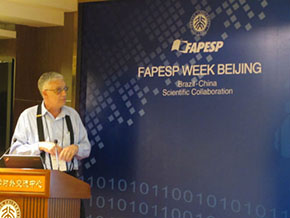

Researcher Paulo Nobre highlights the importance of creating models suited to Brazil’s particular features, and of stimulating a new generation of climate scientists (photo: H.Shimizu)
Researcher Paulo Nobre highlights the importance of creating models suited to Brazil’s particular features, and of stimulating a new generation of climate scientists.
Researcher Paulo Nobre highlights the importance of creating models suited to Brazil’s particular features, and of stimulating a new generation of climate scientists.

Researcher Paulo Nobre highlights the importance of creating models suited to Brazil’s particular features, and of stimulating a new generation of climate scientists (photo: H.Shimizu)
By Heitor Shimizu, in Beijing
Agência FAPESP – The Brazilian Earth System Model (BESM) was presented to Chinese researchers on April 17, the second day of the Brazil-China Symposium for Scientific Collaboration – FAPESP Week Beijing held at Peking University.
According to Paulo Nobre, general coordinator of the BESM and the Network of Brazilian Research on Global Climate Change (Rede Clima), instead of using existing models such as the American or European ones, the BESM is intended as a tool that can aid researchers in examining the factors at play in the Brazilian context, such as intentional burn-offs or deforestation in the Amazon Forest.
“With the BESM, we will be able to produce scenarios for future environmental change, and we’ll have the ability to represent processes that are important to Brazil but that may be regarded as secondary in other models. Another advantage is integration with major research programs, such as BIOTA-FAPESP and the LBA [Large Scale Biosphere-Atmosphere Experiment in Amazonia],” Nobre said.
“Other positive considerations are the ability to train a new generation of scientists capable of producing climate, atmospheric, oceanic, surface and chemical models, in addition to the advancement of climate science and being able to collaborate with countries with similar interests,” said Nobre, who conducts research at the Center for Weather and Climate Studies (CPTEC) at the National Institute for Space Research (INPE).
The BESM is a structural linchpin of climate change research in Brazil, offering support to the FAPESP Research Program on Global Climate Change (RPGCC), Rede Clima and the National Institute of Science and Technology for Climate Change (INCT-MC).
The BESM runs on the Tupã supercomputer, which was acquired by the Ministry of Science, Technology and Innovation (MCTI) and FAPESP and installed at the INPE facility in Cachoeira Paulista, state of São Paulo.
According to Nobre, although the basic physical principles that govern the effects of carbon dioxide concentration in the atmosphere have been known since the 19th century, the knowledge needed to prevent the detailed effects of the build-up of greenhouse gases in the atmosphere is lacking.
“Unlike other drastic local or regional changes that mankind has faced in the past – such as the Black Plague in Europe during the Middle Ages or the threat of nuclear winter during the Cold War era – global climate change presents us with the greatest challenge that mankind has ever faced, given the fact that it requires not only a profound understanding of the physical laws of nature to a degree not yet achieved, but also the processing of an unprecedented amount of data and coverage of the earth system and human society,” he noted.
To confront this enormous challenge, researchers have created mathematical models describing the approximate functioning of the earth system with increasing degrees of complexity, in an attempt to calculate the causes and consequences of the build-up of greenhouse gases in the atmosphere, the biosphere and the oceans, Nobre explained.
“The BESM is a way of incorporating knowledge about the tropical rainforests and tropical oceans into the jigsaw puzzle of global climate change,” he said.
Republish
The Agency FAPESP licenses news via Creative Commons (CC-BY-NC-ND) so that they can be republished free of charge and in a simple way by other digital or printed vehicles. Agência FAPESP must be credited as the source of the content being republished and the name of the reporter (if any) must be attributed. Using the HMTL button below allows compliance with these rules, detailed in Digital Republishing Policy FAPESP.




